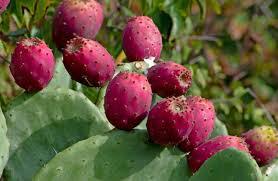Table of Contents
The beautiful flowers of the Central American cactus plant have short lives. They grow, produce their aroma, and die on the same night. However, their medicinal properties remain interesting, making the plant highly appreciated.

Healing Properties and Indications
The flowers contain heart glycosides, flavonoids, and captine, an alkaloid that is very active in the heart. They have cardiotonic, anti-arrhythmia (regulating heartbeat), and vasodilating properties on the coronary arteries. They may complement and even substitute foxglove. Their uses are coronary insufficiency, valve dysfunctions (alterations of the heart valves), heartbeat disorders (palpitations), and angina pectoris (making the sensation of oppression on the chest disappear). The flesh of the fruits contains mucilage with a mild laxative action, and the seeds, a purgative oil.
- Pure Organic Nopal Cactus Powder: We take great care to ensure that we are sourcing our nopal cactus powder from trusted suppliers. This prickly pear supplement is a natural source of Fiber, and is rich in antioxidants as well as Potassium and Vitamin C. This true nopal cactus 1000mg is pure and contains no fillers or additional ingredients.
Cactus Plant Scientific Facts

- French: Cactine.
- Spanish: Cacto.
- Environment: Native to the West Indies and spread all over Central America. It does not grow in Europe.
- Description: A climbing plant of the Cactaceae family, it has fleshy, spiky stems from which aerial roots grow and secure the plant onto rocks and trees. It has big (up to 30 cm), whitish, aromatic flowers and ovoid berries, some 8 cm large.
- Parts of the plant used medicinally: Flowers and fruits (berries).
How to use Cactus
- Flowers: The safest method is to take them as pharmaceutical preparations.
- Flesh of the fruits: From two to ten fruits daily may be eaten.
- Oil of the seeds: From half to one spoonful is enough to obtain its purgative effect.

Queen of The Night
The Selenicerus grandiflorus Britt. Rose, called in some countries giant cactus and mostly “Queen of the Night,” is one of several species of the botanical family of Cactaceae. It is very similar to the Cereus grandiflorus Miller. Their properties are also quite similar. Moreover, the Queen of the Night is a farmed plant since its fruits are valuable in many places, especially in Mexico and the West Indies.
The upright, cylindrical stems of the Cactus genera Cereus and Selenicerus are standard features. Because the different species are not easily distinguishable, they are often given the same familiar names.
Frequently Asked Question
Which parts of the cactus plant offer the most health benefits?
Two main components of cacti are used for their benefits:
1. Cactus Pads (Nopales): The cactus’s flat, green ‘paddles’ offer a different health profile than the fruit. They are rich in fiber, vitamins, and minerals.
2. Prickly Pear Fruit: The brightly colored fruit of the prickly pear cactus is packed with antioxidants, vitamin C, and other beneficial compounds.
How established is the research on cactus plant health benefits?
While traditional medicine has used cactus for centuries, scientific research is still evolving. There’s promising evidence suggesting potential benefits for:
1. Blood Sugar Management: Some studies show cactus pads may help regulate blood sugar levels, especially in individuals with Type 2 diabetes.
2. Cholesterol Reduction: Cactus fiber may help lower cholesterol levels.
3. Anti-inflammatory Effects: Antioxidants in cacti may reduce inflammation linked to various health conditions.
Can cactus plants help with weight management?
Cactus can indirectly support weight management. Its high fiber content promotes feelings of fullness, potentially reducing overall calorie intake. However, it’s not a magic weight-loss solution and should be part of a balanced diet and exercise plan.
What are the different ways to consume the cactus plant for health benefits?
Here are common ways to include cactus in your diet:
1. Grilled or Roasted Cactus Pads: Enjoy them as a side dish or in salads, tacos, or stir-fries.
2. Prickly Pear Juice: Extract the juice or consume it pre-made.
3. Cactus Supplements: Capsules or powders containing cactus extracts are available.
Are there any potential side effects of consuming cactus plants?
Cactus is generally safe for most people when consumed in moderation. Possible mild side effects include:
1. Stomach upset, nausea, diarrhea
2. Headache
3. Bloating
Can cactus interact with any medications?
Yes, there’s potential for cactus to interact with medications, especially those for diabetes, as it may lower blood sugar levels. Always consult your doctor before consuming cactus while on any medications.
Are there specific types of cactus that are better for health benefits?
The prickly pear cactus (Opuntia ficus-indica) is the most widely researched species. Both the pads (nopales) and its fruit offer benefits.
Where can I find reliable sources for further information on cactus health benefits?
Stick to reputable websites and journals:
1. National Institutes of Health (NIH): https://www.ncbi.nlm.nih.gov/
2. Medical News Today: https://www.medicalnewstoday.com/
3. WebMD: https://www.webmd.com/
Is it safe to consume raw cactus pads?
While technically edible, raw cactus pads are not recommended. They have spines and glochids (tiny, hair-like prickles) that can irritate. Thoroughly cook cactus pads before consumption.
Can cactus offer benefits for skin health?
Prickly pear extract is sometimes used in skincare products due to its antioxidant and potential hydrating properties.
DISCLAIMER: All content on this website is presented solely for educational and informational objectives. Do not rely on the information provided as a replacement for advice, diagnosis, or treatment from a qualified medical expert. If you are pregnant, nursing, or have any preexisting medical concerns, talk to your doctor before using any herbal or natural medicines.
REFERENCES
- George D. Pamplona-Roger, M.D. “Encyclopedia of Medicinal Plants.” George D. Pamplona-Roger, M.D. Encyclopedia of Medicinal Plants. Ed. Francesc X. Gelabert. Vols. 1 San Fernando de Henares: Editorial Safeliz, 2000. 216. Print. [cactus plant]
- https://www.webmd.com/diet/health-benefits-cactus
- https://www.medicalnewstoday.com/articles/320293
- https://www.healthline.com/health/nopal
Last update on 2024-07-22 / Affiliate links / Images from Amazon Product Advertising API





